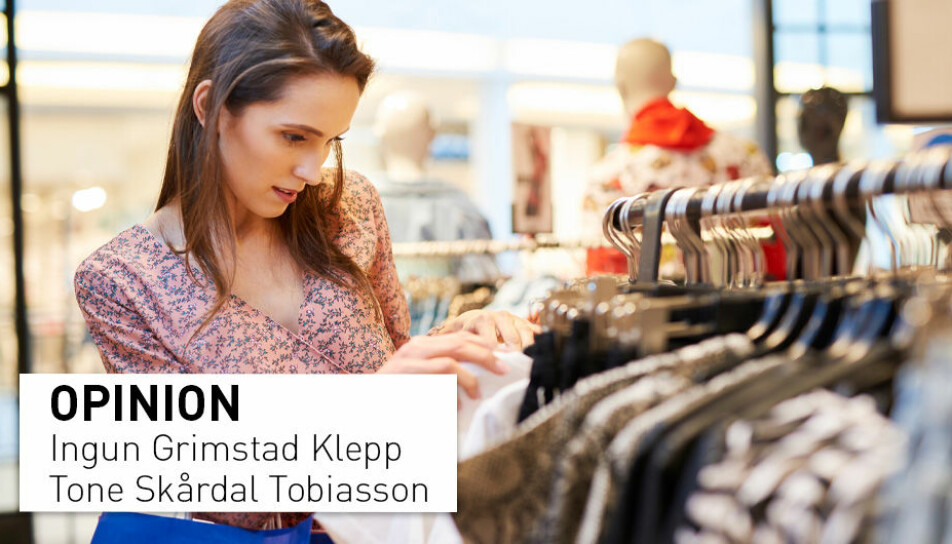Opinion:

Hit them where it hurts: Producers of fast fashion should pay the most
OPINION: How best to deal with the negative environmental impact of the clothing industry? The writers behind this opinion suggest a system in which those who sell large volumes of clothes that don't last pay the most.
The EU’s new textile strategy was launched at the end of March. An important tool is a so-called extended producer responsibility (EPR), which means that producers voluntarily or compulsorily pay for the environmental impacts from the product both in use and as waste.
Rapid growth in fast fashion and overproduction are the main problems in the textile sector. In order for the new strategy to contribute to solving these problems it must be targeted. We have a proposal for how this can be done and have called it targeted producer responsibility.
Those who pollute the most should pay the most
Norway, like all other countries in Europe, has been given three years by the EU to put in place the collection, sorting and further processing of textile waste. It is therefore urgent to set up schemes so that manufacturers pay to develop the systems, technology and infrastructure needed. Some countries are well under way and France introduced a system for producer responsibility several years ago.
A good report that discusses extended producer responsibility for textiles shows that the scheme is effective in raising money. What is more difficult, however, is to influence what and how much is produced.
To achieve this, the expense for those who sell environmentally harmful products must be higher than for those with products that have a lesser impact. This is called "differentiation of producer responsibility" and is desired in our Norwegian waste directive, by the EEA and in the new textile strategy from the EU. But exactly how this will happen, is unclear.
For clothes, however, it is very difficult to set clear criteria for what is a good product. Knowledge and agreement on which clothes are produced with the greatest environmental impact does not exist and it is very difficult to predict which clothes will be used for a long time. Important for good use, is that the clothes fit, sizing, and whether we like them. These are criteria that are very difficult to legislate or measure. Therefore, it is both easier and fairer to see what is actually quickly thrown away.
Reverse the development
In our version of a producer responsibility system, the products' environmental impact is measured when the clothes go out of use, as well as how much it costs to process the used textiles and textile waste into reusable products. The shorter the service life and the more expensive waste treatment, the more the producers have to pay.
An important goal is to reverse the trend from ever shorter use of products, and thus lower utilization rates, and over to products that are used longer. As disposable products and products with a short service life have the largest environmental footprint, they must be phased out first. Those who import or sell clothes that are never used or used only a few times should pay the most. Those who sell things that are used for 10 years or more, and perhaps even inherited, should not pay anything. Targeted producer responsibility pins the blame in the right place.
Amount will be crucial
In the beginning, the system could be based on the amount from each company that appears in the waste and also in the textiles that are donated for reuse. As a digital product passport comes into place (this will be launched by the EU in its textile strategy), or in the least clothes start including the year they enter the market; how long the textiles have been used will be deducted from the calculation. Then the taxation or fee will be differentiated based on the following: actual service life and how much it costs to utilize the materials further in the way that has the least impact on the environment.
This can be various forms of reuse, recycling or energy utilization (burned to provide energy). As investments in better and more local solutions for reuse and recycling systems come into place, prices will be adjusted.
We envisage that analysis of all the different waste streams, including the separate collection of textile waste that will be in place from 2025 in Europe, will form the basis for an annual report. Development of methods for such "picking analysis" is already well underway in the research project Wasted Textiles.
The reports will show how much clothing from the various suppliers is in the waste, and how long they have been in use. The collectors/recyclers will contribute with overviews of how much it actually costs to sort the products for further use, including for repairs for reuse and so-called material recycling - which is all about giving the materials a new life.
- RELATED: Your clothes cause water pollution — but now both the water and the pollutants can be reused
Some will benefit from the system
Some clothes will when they reach this point, have a positive value, because they have a high value in the second-hand market, which can then of course be deducted. Synthetic textiles based on fossil raw materials are subject to an additional tax or fee that compensates for the pollution the product has contributed by spreading microplastics in use and laundering. We do not need to analyze all textiles that end up in the various collection and waste streams, just enough to produce good statistics. For once, it is an advantage that the textile sector has so few and large suppliers.
The highest tax or fee will be triggered on clothes that have not been used, whether they are defective goods, returned goods, surplus stock or goods the consumer has thrown away with the price tag on. The EU wants to ban the destruction of unsold goods, which is fine, but destruction can also be allowed, as long as it costs an arm and a leg.
Small producers will not be part of the new system, as the most important issue is that the large companies, who are constantly pushing for the large volumes, pay. They are the ones who have to take the greatest responsibility for the overproduction of clothes that takes place.
One of the fastest growing players today are online sales-based manufacturers such as Shein and Amazon. One of the great advantages of targeted producer responsibility is that they are captured as efficiently by this system as those who sell via brick-and-mortar stores or Norwegian websites. If the fee is to be tied to sales, online sales from foreign actors will represent a huge loophole that will otherwise give these free riders even more advantages over small, Norwegian actors.
Environmental tax and necessary labeling
It is urgent to get started and therefore a targeted producer responsibility should be introduced step by step. The simplest first: An environmental tax or fee on all textiles, or at least on all synthetic (plastic) textiles, can be introduced immediately. Exactly how the scheme will turn out is not as important as getting started.
What is important, however, is that the money is managed well and independently of the industry itself. One possibility is that Handelens Miljøfond - Norwegian Retailers’ Environmental Fund, which already receives one NOK for each plastic carrier bag, will have its mandate extended to also apply to plastic content in textiles or all clothing. Alternatively, a similar organization could be established.
At the same time, better information on the products should be mandatory. Today, only information about fiber content and how the product is to be maintained is required in Norway. If the mandatory information is extended by manufacturer/brand and year, either when the product was manufactured or imported, much has been achieved. The point is that if the manufacturer is to be held responsible for the product's final fate, we need to know who is responsible for the product and when this company handed over the responsibility to someone else.
Let the polluters pay so they hurt
In the EU's environmental strategy for textiles and footwear, they have a vision that by 2030 Europe will have products with a long service life, at the same time as «fast fashion is out of fashion». These are of course great goals, but we will not get there without good tools and actual measures. Unfortunately, the EU's textile strategy currently is merely good intentions and pious wishes, such as appealing to the fast fashion industry to have "fewer collections per year".
The advantage of our proposal is that it attacks at the core of the problem. Manufacturers with large volumes and poor products have to pay the most and imports through online sales are equated with in-store sales. Targeted producer responsibility is dynamic and based on knowledge of the products' final fate. The price manufacturers have to pay reflects the real cost to society of preventing pollution and keeping the clothes or materials in them in use as long as possible.
------
Share your science or have an opinion in the Researchers' zone
The ScienceNorway Researchers' zone consists of opinions, blogs and popular science pieces written by researchers and scientists from or based in Norway. Want to contribute? Send us an email!






























